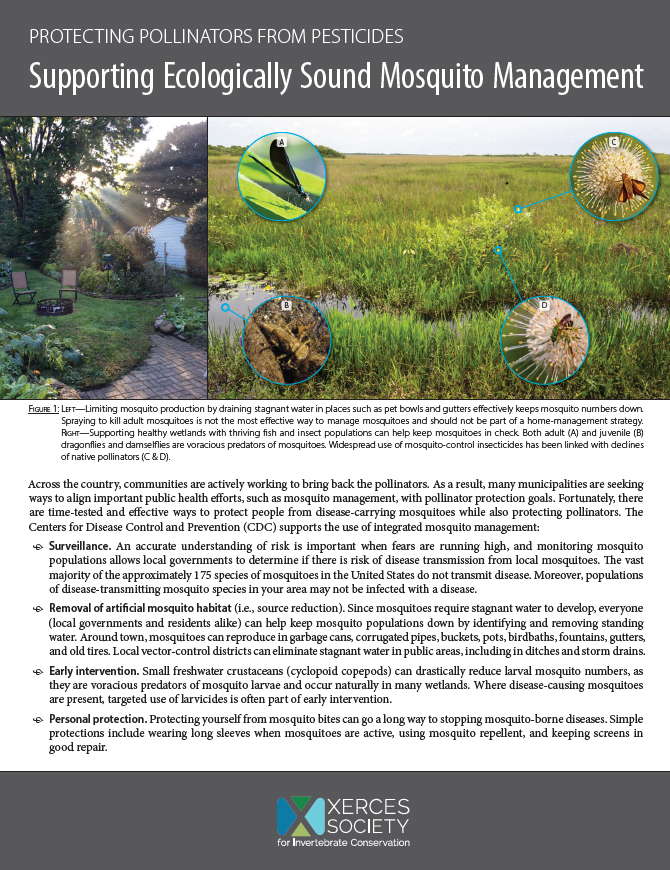Now, more than ever, we recognize the critical importance of taking preventative steps to preserve public health.
As the weather warms and spring rains come down, everything starts to wake up. Along with April flowers, mosquitoes might also start emerging. While the buzz of a bumble bee is often welcome, the buzz of a circling mosquito is not—especially if there is a risk of mosquito-borne disease.
 The Xerces Society’s new fact sheet, Protecting Pollinators from Pesticides: Supporting Ecologically Sound Mosquito Management, highlights ways for everyone to prevent mosquito-borne disease, with recommendations that are backed by the Centers for Disease Control and Prevention (CDC). For instance, did you know that the first line of defense isn’t spraying pesticides throughout our communities, over homes, schools, wetlands, and other sensitive sites? Not only are such aerial spray efforts not the most effective strategies for protecting people, they also put pollinators at risk.
The Xerces Society’s new fact sheet, Protecting Pollinators from Pesticides: Supporting Ecologically Sound Mosquito Management, highlights ways for everyone to prevent mosquito-borne disease, with recommendations that are backed by the Centers for Disease Control and Prevention (CDC). For instance, did you know that the first line of defense isn’t spraying pesticides throughout our communities, over homes, schools, wetlands, and other sensitive sites? Not only are such aerial spray efforts not the most effective strategies for protecting people, they also put pollinators at risk.
The best strategy is a preventative measure that limits where mosquitoes reproduce: Stagnant water. Here’s where you can really make a contribution because the source of this problem may be right under your nose, or over your head. Standing water might be sitting on your property—in garbage cans, buckets, pots, birdbaths, fountains, gutters, corrugated drain pipes, or old tires. You can do your part year-round by making sure these sorts of items are draining, emptied, and/or kept dry. Water shouldn’t sit for more than a couple of days, especially when temperatures are warm.
One key fact to remember regarding mosquito-borne disease is that only a few of the 175 mosquito species in the United States transmit disease—and even the species that can transmit may not be carrying the disease. In other words, seeing every mosquito as a threat and responding with pesticides is unnecessary.
The better, smarter strategy is figuring out which species are present and whether they are actually carrying disease. Vector control districts can—and should—monitor mosquito populations carefully so that any intervention programs can be carried out early and effectively against actual hotspots of disease-carrying mosquitoes.
As we move into mosquito season, remember that if disease-carrying mosquitoes are an issue in your area, you can take steps to avoid being bitten. Wear long sleeves outside and make sure your window and door screens are in good repair.
You can read about communities that are implementing effective and ecologically sound practices in our fact sheet.
And don’t forget to check in with your vector control district this year. Ask them what kind of monitoring program they run, and if they’re investing in public education and communications to make sure everyone knows what they can do to stay safe and healthy through common-sense prevention measures.
Further Reading
Fact sheet: Supporting Ecologically Sound Mosquito Management
Read more Xerces resources on mosquito management.
Learn more about the Xerces Society’s Pesticide Program.
Check out the rest of our Earth Week content!




